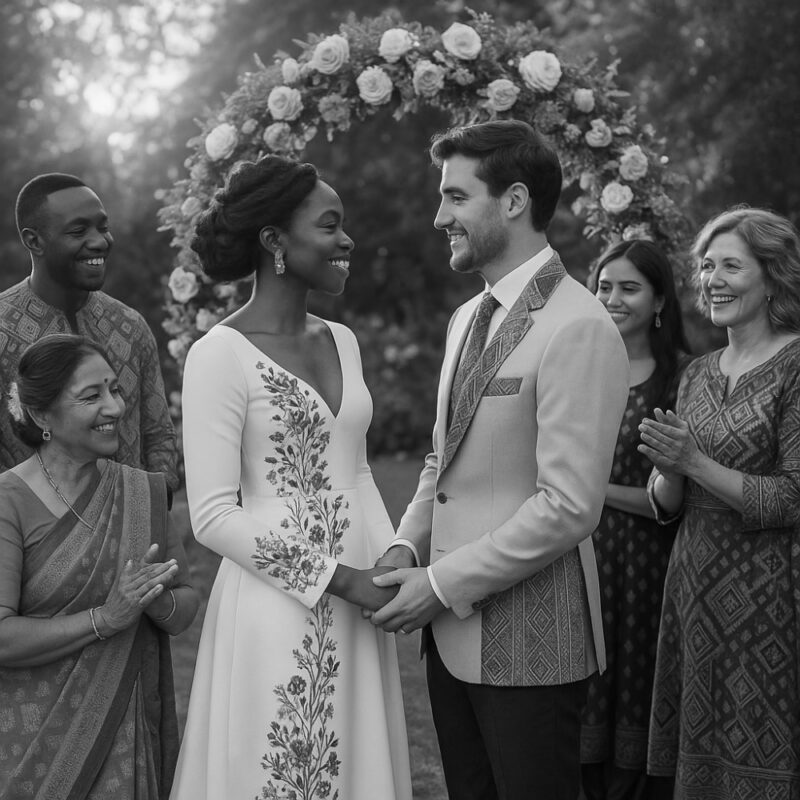-
×
 Have a Nice Day T-Shirt
1 × $111.00
Have a Nice Day T-Shirt
1 × $111.00
When Fashion Carries Generations Forward
Weddings are more than celebrations of love — they are milestones where clothing tells a story of heritage, identity, and individuality. In recent years, cultural wedding fashion has emerged as a powerful force, influencing not only what couples wear at the altar but also how guests, designers, and entire communities engage with style. This movement honors the past while embracing the possibilities of modern design.
The Growing Appeal of Cultural Wedding Fashion
Couples today are increasingly turning to cultural wedding fashion as a way to connect with their roots. Rather than viewing tradition as restrictive, brides and grooms see it as an opportunity for creativity. A bride may opt for a gown with the clean structure of Western couture, yet it may feature embroidery or beadwork inspired by her heritage. Grooms, too, are exploring textiles, patterns, and tailoring techniques that carry symbolic meaning. The outcome is attire that feels timeless and personal, rather than bound by a single cultural script.
Blending Modernity With Cultural Wedding Fashion
At the heart of cultural wedding fashion is balance. Many couples want their attire to speak to family history, yet they also want it to reflect their individuality. This can mean pairing a minimalist gown with an heirloom veil, or reinterpreting a sari or kimono in contemporary fabrics and cuts. The result is not a compromise but a fusion — a way to respect heritage while embracing the aesthetics of the present. Fashion becomes a canvas where history and modernity meet.
Designers Leading the Evolution of Cultural Wedding Fashion
The bridal industry has embraced this demand. Major fashion houses now incorporate multicultural influences into their collections, while independent designers are celebrated for tailoring pieces that reflect both tradition and innovation. From African prints reimagined in sleek silhouettes to East Asian embroidery adapted to modern gowns, the influence of cultural wedding fashion is seen on runways and in boutiques alike. These efforts show that bridal style has moved beyond uniformity and into a space where diversity is central.
The Role of Symbolism in Wedding Attire
Clothing choices at weddings are rarely just aesthetic. In cultural wedding fashion, fabrics, colors, and patterns often carry layered meanings. Red might symbolize prosperity, gold could represent abundance, while handwoven textiles may link a family to its ancestral land. By choosing these elements intentionally, couples infuse their ceremony with symbolism that resonates far beyond the visual, making fashion an integral part of the narrative.
Guests Embracing Cultural Expression
It is not only the bride and groom who contribute to this shift. Guests increasingly embrace cultural elements in their attire, creating a collective sense of celebration. A shawl embroidered with regional motifs, jewelry rooted in heritage, or even accessories borrowed from family traditions allow attendees to participate in a shared cultural dialogue. Rather than appearing costume-like, these choices express respect for the couple’s background and contribute to the overall atmosphere of authenticity.
A Lasting Influence on Modern Weddings
The growing influence of cultural wedding fashion suggests it is not a passing trend. Instead, it reflects the global nature of today’s society, where cultures interact and inspire one another. As weddings continue to evolve, this blending of heritage and modernity will likely remain central. Fashion becomes more than decoration — it is a bridge connecting generations, ensuring that traditions live on while allowing for fresh interpretations. Couples are not simply wearing garments; they are carrying stories forward into new chapters of life.





